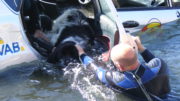In 1999 a small group of Belgian lifeguards started The International Water Rescue Dog Academy’, a project that aimed at developing and restoring the use of the instinctive lifesaving skills of the Newfoundland dog.
During centuries the Newfoundland and land seer dogs were one of the main rescue tools used. They saved many lives and they never backed away from fog or storms. The price they paid for their dedication was very high as many dogs lost their lives in rescue actions.
With the development of new rescue equipment and better trained lifeguards the dog’s natural behavior was developed into a sporty hobby. Because of these ‘water trials’ the dogs retained their instinctive “water rescue behavior”.
The main purpose of the Academy is to restore the skills of these magnificent and friendly animals.
With the support of the Belgian Lifesaving Federation a course was developed. As a member of a rescue team, the dog must assist his/her handler, who is a trained lifeguard, or must act as a lifeguard him/herself during a rescue mission.
The swimming and buoyancy skills of the Newfoundland and landseer dogs are very particular. They can swim over two miles and keep afloat a drowning victim for more than one hour. They can bring a rescue tube to a victim or tow an IRB boat with 10 people to shore. Unconscious victims are taken by the wrist, gently between the teeth. Where a human lifeguard must pull back in freezing water for danger of hypothermia, this rescue dog can go on under zero degrees temperature.
The Belgian Lifesaving Federation currently has four licensed Water Rescue Dog Teams. The Teams regularly hold demonstrations and are acting as lifeguards during several water sports events.

